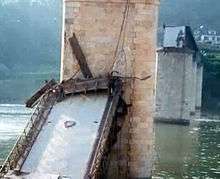Hintze Ribeiro disaster

On the night of 4 March 2001, the Hintze Ribeiro disaster (also known as Entre-os-Rios disaster) occurred when the Hintze Ribeiro Bridge, made of steel and concrete, collapsed in Entre-os-Rios, Castelo de Paiva, Portugal, killing 59 people, including those in a bus and three cars that were crossing the Douro river.
Fast waters and a storm at the time gave no chance for an immediate rescue, and the victims drowned. The strong river current carried bodies downstream more than 30 kilometers (19 mi) to the Atlantic ocean. Bodies were found as far away as the north coast of Spain and one even in France.
Hours after the accident, the then Minister of Transportation Jorge Coelho resigned. The following week, dozens of bridges across Portugal were closed for immediate repair. The tragedy caused widespread shock across the nation, with all television networks broadcasting continuous news bulletins, and many solidarity campaigns being organized to help the victims' relatives.
The bridge had linked Castelo de Paiva and Entre os Rios. After the loss of the bridge, residents of Castelo de Paiva had to travel an additional 70 km to reach the Porto area.[1]
The bridge was more than 100 years old. The collapse was caused by "two decades of uncontrolled sand extraction, which compromised the stability of the bridge's pillars, together with underestimating the warnings from divers and technicians."[2] Only the sand extractors were prosecuted and sued.
Coordinates: 41°04′44.62″N 8°17′47.10″W / 41.0790611°N 8.2964167°W
See also
References
- ↑ http://eur-lex.europa.eu/LexUriServ/LexUriServ.do?uri=OJ:C:2001:261E:0233:0234:EN:PDF
- ↑ Sousa, J. J.; Bastos, L. (18 March 2013). "Multi-temporal SAR interferometry reveals acceleration of bridge sinking before collapse". Nat. Hazards Earth Syst. Sci. 13 (3): 659–667. doi:10.5194/nhess-13-659-2013. Retrieved 19 March 2018 – via Copernicus Online Journals.